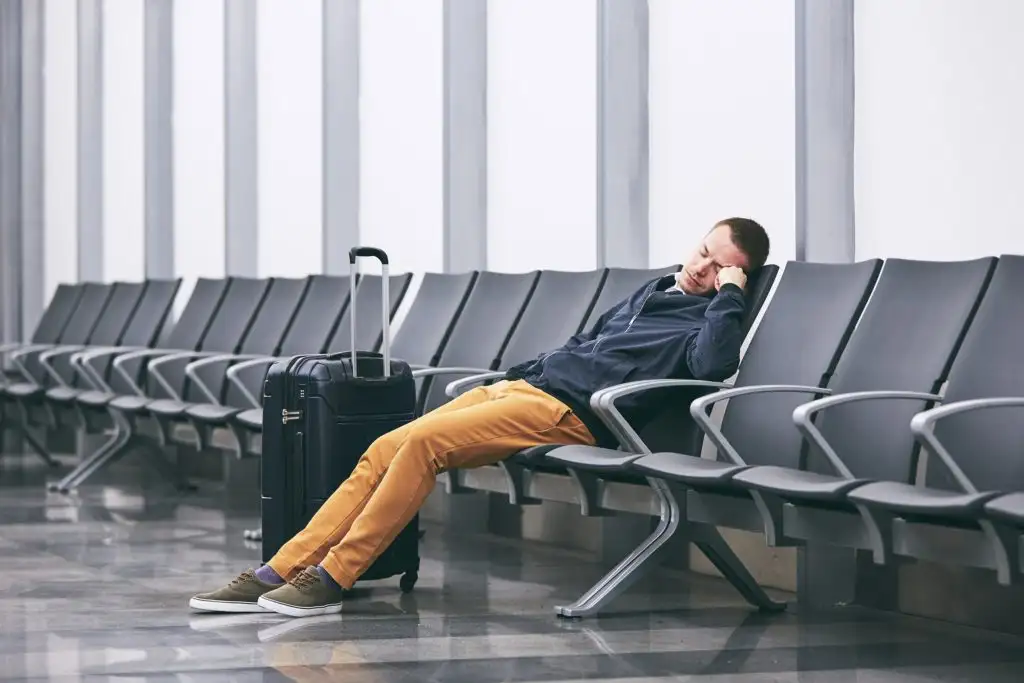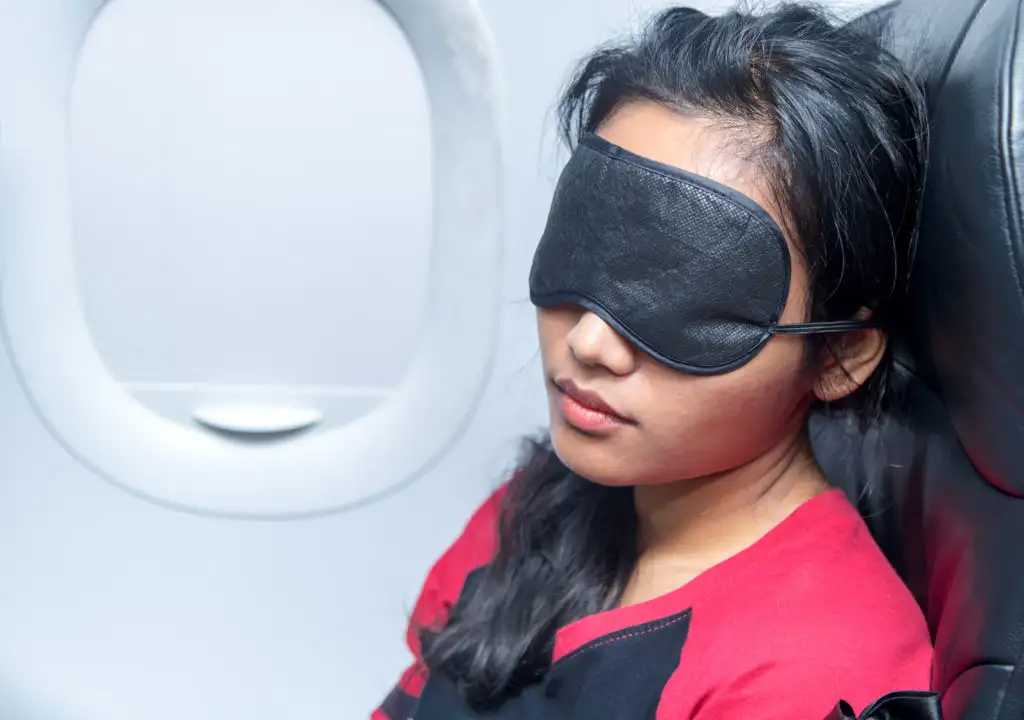For seasoned globetrotters, jet lag is an all-too-familiar part of international travel—the fatigue, the disorientation, and especially that pesky inner alarm that wakes you up at 4:00 a.m. and sends you stumbling back to bed before dinnertime. While there’s no real cure, the advice below explains how to avoid jet lag and which remedies are most likely to help.
Some of the links featured in this story are affiliate links, and SmarterTravel may collect a commission (at no cost to you) if you shop through them.
What Is Jet Lag?

Jet lag is a physical reaction to a rapid change in time zones. It affects most travelers, including seasoned flyers like flight attendants and pilots. Common symptoms include disorientation, irritability, insomnia, fatigue, dry eyes, headaches, irregular bowels, and general malaise.
Note that flying from, say, New York City to Santiago won’t produce jet lag in the true sense because both cities are in the same time zone—but the effects of the long flight might feel quite a bit like classic jet lag. In these cases, you’re just tired from the flight, and a good night’s sleep and perhaps some exercise will set things right.
On long flights—especially red-eye flights—you often lose several hours of sleep time, which can set you back considerably even without the jarring time change. If you live by a regular schedule (up at 7:00 a.m., in bed by 10:00 p.m. every night), watch out. Jet lag hits those with rigid body clocks the hardest. Parents should be sure to bring along books and toys your child can play with on his or her own, in case the jet lag hits you differently than it does your little ones.
A general rule of thumb to keep in mind before any long trip is the 1:1 ratio: Allow yourself one day to recover for every hour of time difference that you experience. Some people find that they recover from jet lag more easily when traveling west instead of east (or vice versa).
How to Prevent Jet Lag: Before You Go
Treat your body well before you fly. Although it may be tempting to stay up all night before your flight in order to more easily fall asleep onboard, you should do the opposite. Jet lag can hit you harder if you’re tired, sick, or hungover. Be sure to get a good night’s sleep before you board your flight. Exercise, sleep well, stay hydrated, and stay sober. The worst thing you can do is get on a long flight with a hangover.
Some travelers like to exercise right before they go to the airport. (This can actually help you sleep better on the plane.) Once you’re at the airport, avoid the escalators and moving sidewalks. Instead, walk and take the stairs on the way to your check-in area and gate connections.
Adjust your habits before you leave. For example, if you’re traveling from the East to the West Coast of the U.S., you’re facing a three-hour time change and you should try to adjust your internal clock. A few days before you leave, try to stay up a little later than usual, and sleep in a little longer. If you become accustomed to falling asleep at 12:00 a.m. and waking up at 8:00 a.m. on the East Coast, it will be the same as falling asleep at 9:00 p.m. and waking up at 5:00 a.m. on the West Coast, getting you one step closer to the time zone you’ll be in. Traveling west to east, do the opposite: Get up and go to bed earlier.
During the Flight

Perhaps the best way to avoid jet lag while in flight is to treat your body well. Stay hydrated by drinking plenty of non-alcoholic, non-caffeinated fluids. Dehydration has been shown to amplify some of the symptoms of jet lag, making you feel even worse. Don’t be afraid to ask your flight attendant for extra water.
Set your watch to the time in your destination as soon as you take off so you can start training your brain on the new schedule.
If you’ll be arriving in the morning at your destination, it’s a good idea to try to sleep on the flight. Wear comfortable, loose-fitting clothing, and pack a neck pillow, eye mask, ear plugs, or noise-canceling headphones in your carry-on to help you block out the distractions around you. To help you get more rest in flight, see our tips for sleeping on planes.
Meanwhile, if you’ll be arriving late at your destination, you might want to avoid anything more than a brief nap on the plane; that way you’ll be tired enough to sleep when you arrive. Queue up a few movies on your seatback screen, read a good book, and get up out of your seat at regular intervals to walk and stretch. You can also do exercises like toe raises, isometric exercises, stomach crunches, and shoulder shrugs right in your seat. This keeps your blood flowing and prevents it from pooling at your extremities, a common phenomenon in pressurized cabins. If you’re in a window seat, consider putting up the shade to let natural light in; it’ll help keep you awake.
When You Land
Stay awake until the evening when you arrive. It’s painful, especially if you didn’t manage much sleep on the plane, but you’ll have an easier time on the rest of your trip if you can stay awake at least until the early evening of the first day. Walking around outdoors and getting some natural light can help adjust your body’s circadian rhythms. You’ll also want to continue to keep yourself well hydrated.
Jet Lag Remedies: Medication and Light Therapy

Melatonin is a chemical in the body that helps regulate sleep cycles. It can be taken in pill form, and many travelers swear by it for fighting jet lag. However, as popular as melatonin is, it’s also controversial. Studies have indicated that incorrect melatonin usage can make you feel even more fatigued, and its dosage isn’t regulated, so be sure to read all instructions and consult your physician before taking the product.
One widely available homeopathic remedy is the aptly named No-Jet-Lag. The company claims the chewable tablets address all jet lag symptoms, and offers testimonials from flight attendants and other frequent flyers. A bag of dried cherries is another natural remedy that some travelers use, as these are a good source of melatonin.
Some travelers use sleeping pills, antihistamines, and motion sickness pills to induce sleep on planes and at hotels after arrival. While they work for some, others are left feeling miserably groggy. Be sure to try any over-the-counter sleep aids at home before your trip—you don’t want to find out you’re allergic to any ingredients while you’re trapped on the airplane. Likewise, melatonin can cause nightmares in some people—also not fun at 30,000 feet. Always consult your doctor before trying any remedies, as some herbs can interact with prescription medications.
If all else fails, try an alternate therapy. Light therapy has become a popular treatment for jet lag. At its heart, jet lag means you’re out of step with the rising and setting of the sun, so exposing yourself to light at the appropriate time can theoretically help you align your body with your new time zone.
Unfortunately, the jury’s still out on the effectiveness of this. The debate centers on precisely which kind of light is best—natural, artificial, bright, or dim. One study even found that flashing light might be best. Some researchers and enthusiasts recommend avoiding light on flights by wearing sunglasses onboard and in the airport, then simply spending 15 to 20 minutes in direct sunlight without sunglasses as soon as possible after landing.
Jet Lag Apps
Several smartphone apps have been developed to help travelers avoid jet lag. Enter your flight details into Timeshifter (iOS | Android) or Entrain (iOS | Android), and they’ll create a suggested schedule of when to sleep, avoid caffeine, or expose yourself to bright light to prepare for the time change. Another option is the Uplift app (iOS | Android), which uses biorhythmic acupressure to help you reset your body clock.
Dietary Tactics to Prevent Jet Lag

The so-called “jet lag diet,” an alternation of feasting and fasting for three days leading up to a long-haul flight, was very popular a few years back. Recent research suggests that fasting for 12 to 16 hours before breakfast time at your destination is an effective simplification of the original diet—as long as you’re willing to ingest nothing but water on your long-haul flight.
If can’t or don’t want to fast, restrict your diet to foods that are easily digested and not too rich. If you’re trying to stay awake in order to get your body in step with the local time zone, caffeine can be useful—but don’t go overboard. While it might seem tempting to guzzle several cups of coffee when your eyelids begin to droop, you could end up wide awake at 1:00 a.m. Be sure to implement all dietary changes in moderation.
Editor’s note: This story was originally published in 2017. It has been updated to reflect the most current information. Molly Feltner, Caroline Morse Teel, and Margaret Leahy contributed to this story.
You Might Also Like:
• Luggage Locks: Should I Lock My Suitcase When I Fly?• 7 Air Travel Secrets You Didn’t Know
• The 11 Best Stocking Stuffers for Travelers
• Flying with Gifts: The TSA Rules You Need to Know
• 9 Times You’ll Regret Being Cheap When You Travel
We hand-pick everything we recommend and select items through testing and reviews. Some products are sent to us free of charge with no incentive to offer a favorable review. We offer our unbiased opinions and do not accept compensation to review products. All items are in stock and prices are accurate at the time of publication. If you buy something through our links, we may earn a commission.
Related
Top Fares From
Today's Top Travel Deals
Brought to you by ShermansTravel
Kenya: 14-Night Tour, Incl. Tanzania &...
smarTours
 vacation
$7125+
vacation
$7125+
Sydney Cruisetour
Norwegian Cruise Line
 cruise
$3296+
cruise
$3296+
Ohio: Daily Car Rentals from Cincinnati
85OFF.com
 Car Rental
$19+
Car Rental
$19+




